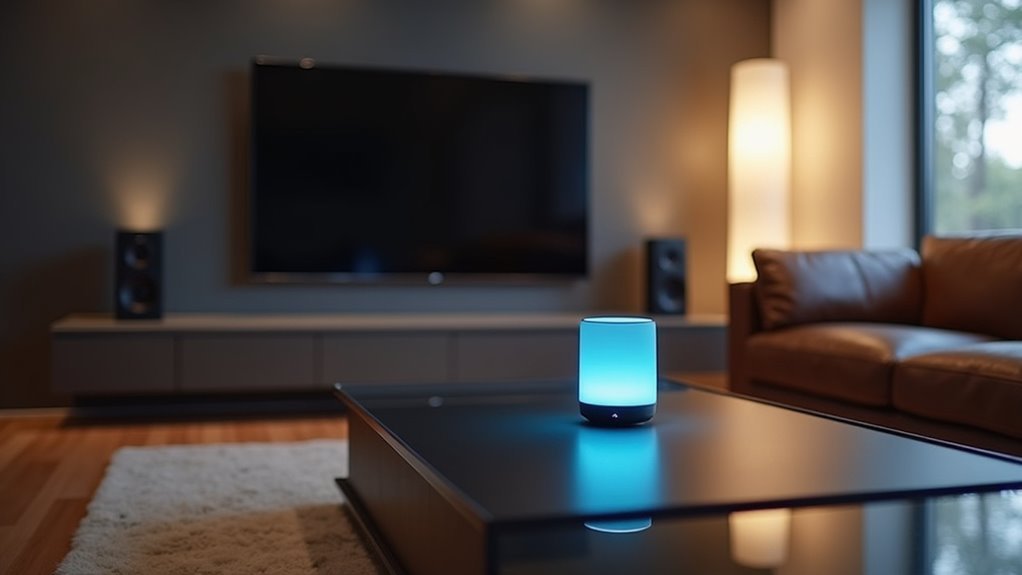You’ve probably looked at your vertical blinds and wondered if there’s a way to make them smart without ripping everything out and starting fresh. The reality is that vertical blinds present unique automation challenges that most people don’t anticipate—requiring solutions for both horizontal movement and slat rotation. However, recent innovations have made it possible to retrofit your existing system with surprising effectiveness, though the approach you choose will determine whether you’re satisfied with the results or left frustrated.
Why Vertical Blinds Are Challenging to Automate

While automating horizontal blinds has become relatively straightforward, vertical blinds present unique engineering challenges that make them considerably more complex to modernize.
Unlike horizontal systems that typically use cord-pulling mechanisms, your vertical blinds require two distinct motor functions: horizontal movement across the track and individual vane rotation. This dual-operation system means existing automation solutions designed for cord-operated blinds won’t work with your rod-based vertical setup.
You’ll also encounter significant compatibility issues with popular automation products. Many devices like SwitchBot don’t fit standard vertical blind tracks, and their performance with larger channels remains questionable.
Even when retrofitting is possible, you’ll need to carefully evaluate components and potentially make substantial modifications to your current manual system, making automation far more complex than expected.
Understanding Your Current Vertical Blind System
Before investing in any automation solution, you’ll need to thoroughly examine your current vertical blind setup to determine what type of motors and components will work with your existing hardware. Your existing blinds operate on a rod system enabling both vertical movement and vane rotation. Most automation options require separate motors for these functions, so compatibility assessment is essential.
| Component | Manual Operation | Automated Requirement | Compatibility Check |
|---|---|---|---|
| Draw Rod | Pull cord/chain | Horizontal motor | Rod diameter/weight |
| Wand | Hand rotation | Rotation motor | Wand accessibility |
| Headrail | Fixed mounting | Motor housing | Space availability |
| Vanes | Gravity hang | Load capacity | Weight distribution |
Understanding your mechanism’s specifics helps you select appropriate automation products like the Sunsa Wand, designed for retrofitting without complete replacement.
The Two-Motor Problem: Horizontal Movement vs. Rotation

Once you’ve assessed your current system’s compatibility, you’ll face the fundamental challenge of vertical blind automation: operating two distinct functions with separate motors.
Your vertical blinds require one motor for horizontal movement along the track, allowing you to open and close the blinds completely. The second motor handles vane rotation, controlling light direction and privacy levels.
Vertical blind automation demands dual motors: one for track movement, another for vane rotation and light control.
This dual-motor requirement distinguishes vertical blinds from other window coverings. You can’t simply use motors designed for horizontal blinds or roller shades—they won’t work properly. The mechanics are entirely different, requiring specialized components that understand vertical blind operations.
The Sunsa Wand offers an effective solution, specifically designed to automate vertical blinds by managing rod rotation efficiently.
When you choose retrofit automation systems, verify they’re engineered for vertical blind mechanics rather than adapting incompatible horizontal blind motors.
Evaluating Retrofit vs. Replacement Costs
How much should you budget for vertical blind automation? You’ll face two main options: retrofit your existing blinds or replace them entirely.
Retrofitting typically costs $100 to $300 for specialized motors, while replacement ranges from $300 to $700 plus potential installation fees of $100 to $200.
The cost-effectiveness of each approach depends heavily on your current blinds’ condition and quality. If they’re in good shape, retrofitting can save you 50% or more compared to replacement.
DIY retrofitting reduces expenses further by minimizing waste and utilizing existing components.
Consider long-term benefits when evaluating costs. Both options provide energy efficiency and convenience, but replacement offers newer technology and warranties.
Weigh your budget against desired features and your blinds’ current state.
Sunsa Wand: The Simple Wand Automation Solution

You’ll find the Sunsa Wand offers an exceptionally straightforward path to blind automation with its remarkably quick two-minute installation process.
The device seamlessly connects to your existing smart home ecosystem, including Amazon Alexa, while providing extensive app-based control for scheduling and remote operation.
This affordable upgrade transforms your manual blinds into a fully automated system without requiring permanent modifications to your home.
Easy Two-Minute Installation
Installing the Sunsa Wand takes just two minutes and requires zero special tools or technical expertise. You’ll transform your existing blinds into smart blinds without any permanent modifications, making this solution perfect for renters.
The installation process is remarkably straightforward:
| Step | Action |
|---|---|
| 1 | Attach the Sunsa Wand to your blind’s wand mechanism |
| 2 | Connect the device to your Wi-Fi network |
| 3 | Download the mobile app on your smartphone |
| 4 | Pair the device through the easy to use interface |
| 5 | Begin controlling your blinds remotely |
No drilling, screwing, or complex wiring is involved. The installation maintains your blinds’ original functionality while adding automation capabilities. You’ll immediately gain access to scheduling features and group control options through the intuitive app.
Smart Home Integration
Smart home integration transforms the Sunsa Wand from a convenient automation device into a powerful component of your connected ecosystem. You’ll connect the wand to your Wi-Fi network, enabling seamless communication with other smart devices throughout your home.
The mobile app lets you automatically open and close multiple blinds simultaneously, creating coordinated lighting schedules that work with your daily routines. You can program blinds to open at sunrise or close during peak sun hours, optimizing natural light and energy efficiency.
Since it’s compatible with Alexa, you’ll control your blinds through simple voice commands. Say “Alexa, close the living room blinds” and watch them respond instantly.
Regular app updates continuously add new features, ensuring your automation system evolves with advancing smart home technology.
Affordable Automation Upgrade
Since replacing entire window treatments can cost hundreds or thousands of dollars, the Sunsa Wand offers a budget-friendly alternative that transforms your existing vertical blinds into smart home devices.
You’ll get professional automation features without the premium price tag.
This affordable upgrade delivers extensive smart home functionality through its intuitive mobile app:
- Quick 2-minute installation with no tools required
- AA battery operation eliminates wiring costs
- Wi-Fi connectivity for seamless smartphone control
- Automated scheduling for daily open/close routines
- Amazon Alexa integration for hands-free voice commands
You won’t need to sacrifice your current blinds’ appearance or functionality.
The Sunsa Wand works with your existing setup, making it perfect for renters who can’t make permanent modifications or homeowners seeking cost-effective automation solutions.
E-Wand Battery-Powered Alternative for Existing Setups
While replacing entire window treatments can be expensive and time-consuming, the E-Wand offers a battery-powered solution that transforms your existing vertical blinds into smart, automated systems within minutes.
This retrofitting device specifically targets wand-operated vertical blinds, eliminating the need for complete replacement.
You’ll appreciate the straightforward installation process that typically requires just a few minutes of your time.
Once installed, the E-Wand integrates seamlessly with major smart home platforms like SmartThings, giving you full control through mobile apps or voice commands.
The automation capabilities allow you to create custom schedules for opening and closing your blinds, optimizing natural light management and energy efficiency.
This cost-effective alternative delivers the convenience of motorized blinds without the expense of purchasing entirely new window treatments.
SwitchBot Limitations for Vertical Blind Applications
Although SwitchBot has gained popularity for automating window treatments, its motors aren’t designed to handle the unique mechanical requirements of vertical blinds.
You’ll encounter significant limitations when attempting to use SwitchBot for vertical blind automation.
The fundamental issue lies in SwitchBot’s horizontal-focused design. Vertical blinds require both lateral movement and vane rotation, operations that SwitchBot can’t adequately perform.
Key limitations include:
- Motors designed exclusively for horizontal blinds and rollers
- No mechanism for rotating vertical blind rods
- Uncertain compatibility with standard vertical blind channels
- Installation challenges requiring engineering modifications
- Need for separate motors to handle dual movement requirements
You’ll find that retrofitting existing vertical blinds with SwitchBot devices often proves impractical, making it an unsuitable choice for thorough vertical blind automation.
Smart Home Integration: Compatibility With Alexa and Smartthings
When choosing vertical blind automation solutions, you’ll want to prioritize devices that integrate seamlessly with your existing smart home ecosystem.
The Sunsa Wand offers excellent Amazon Alexa compatibility, letting you control your vertical blinds through simple voice commands. For SmartThings users, both Graywind integrated smart blinds and the E-Wand provide confirmed compatibility, making them ideal choices for automation without extensive retrofitting.
However, you should be prepared for potential custom setups and programming, particularly when using separate motors for horizontal movement and vane rotation with SmartThings.
Before purchasing any automation solution, verify that your chosen device works with your current smart home platform. This guarantees peak functionality and prevents compatibility issues that could complicate your automation goals.
Installation Requirements and Track Modifications
Once you’ve selected a compatible automation device, you’ll need to address the physical installation requirements for your vertical blind system. Most retrofits require dual motors since standard units can’t handle both horizontal movement and vane rotation simultaneously. Your existing setup will likely need modifications to accommodate automation integration effectively.
Key installation requirements include:
Proper measurements, mounting solutions, track modifications, and compatibility verification ensure seamless automation integration without operational binding or performance issues.
- Precise measurements to prevent compatibility issues with automation devices
- Mounting solutions that guarantee smooth rod sliding on tracks during operation
- Track modifications to support automated movement without binding
- Rod and track system adjustments for maximum performance
- Compatibility verification between your existing blind tracks and chosen automation solution
While some devices like the Sunsa Wand offer quick installation, confirming track compatibility beforehand prevents costly installation delays.
Addressing Safety Concerns With Pets and Children
When you’re automating vertical blinds in homes with pets and children, you’ll want to prioritize cord-free motor solutions that eliminate strangulation and entanglement risks entirely.
These modern systems let you control your blinds remotely without any dangling cords that could pose safety hazards.
You’ll also need to position control devices and motors high enough that curious children can’t reach them while ensuring the automated mechanisms are securely mounted to prevent accidents.
Cord-Free Motor Solutions
Every year, thousands of accidents occur when pets and children become entangled in blind cords, making cord-free motor solutions an essential safety upgrade for homes with vertical blinds.
These innovative systems eliminate dangerous hanging cords while maintaining full functionality of your window treatments.
When you automate vertical blinds with cord-free technology, you’re choosing the safest option available.
Smart blinds offer multiple benefits beyond enhanced safety:
- Battery-operated motors like the E-Wand retrofit existing blinds without permanent modifications
- The Sunsa Wand provides non-permanent automation that’s completely cord-free
- Programmable scheduling allows remote operation without manual adjustments
- Retrofitting reduces accident risks associated with traditional corded systems
- Smart controls enable convenient light and privacy management from anywhere
Child-Safe Device Positioning
Beyond selecting cord-free motors, proper device positioning becomes your next line of defense against potential hazards.
When installing automated systems like the Sunsa Wand, mount control units and receivers out of children’s reach while ensuring easy adult access. Position motors high enough that curious hands can’t tamper with mechanisms, yet accessible for maintenance.
Smart scheduling features help maintain child-safe positioning by preventing blinds from remaining in potentially dangerous configurations. You’ll want to program automatic adjustments that keep slats at appropriate heights throughout the day. This eliminates safety risks associated with manual repositioning.
Regular monitoring allows you to fine-tune settings based on your family’s needs. Adjust automated positioning to account for furniture placement, play areas, and pet zones, ensuring your vertical blind automation prioritizes safety without sacrificing functionality.
Battery Life and Power Options for Automated Systems
Although automated vertical blind systems offer impressive convenience, their power requirements directly impact how reliably they’ll operate in your home.
Power reliability is the foundation of any automated blind system’s long-term performance and user satisfaction.
Battery life and power options for automated systems like the Sunsa Wand deserve careful consideration before installation.
Most battery-operated automated systems use AA batteries lasting 9-12 months with regular use.
Here are your main power considerations:
- Battery monitoring – Check power levels regularly to prevent unexpected system failures
- Wall adapter option – Available for continuous power, though currently experiencing supply shortages
- Solar charging – Some systems offer eco-friendly solar options for energy savings
- Usage frequency – Heavy daily use will drain batteries faster than occasional operation
- Backup power – Consider having spare batteries ready for seamless changes
Choose power options that match your maintenance preferences and usage patterns.
Programming Schedules and Temperature-Based Controls
You’ll want to set up daily schedules that automatically open and close your vertical blinds at specific times throughout the day.
Most systems let you create custom programming through their mobile apps, allowing you to optimize natural light and reduce energy costs.
You can also enable temperature sensor automation that adjusts your blinds based on indoor climate readings, maintaining comfortable temperatures while maximizing efficiency.
Daily Schedule Setup
When you’re ready to maximize both comfort and energy efficiency, setting up daily schedules transforms your automated vertical blinds into a smart climate management system.
The Sunsa Wand app lets you create customized schedules that automatically close your blinds during peak sun hours and open them when natural light’s beneficial. Temperature sensor integration guarantees your blinds respond to actual conditions rather than just time-based triggers.
Your daily scheduling options include:
- Morning routines – Gradual opening to welcome natural light
- Midday protection – Automatic closure during intense heat periods
- Evening optimization – Strategic positioning for privacy and insulation
- Group coordination – Synchronized operation across multiple rooms
- Override capabilities – Manual adjustments when needed
Smart home integration amplifies these features, creating thorough climate control that adapts throughout your day.
Temperature Sensor Automation
Temperature sensor automation takes your blind control beyond fixed time schedules, creating a responsive system that reacts to actual environmental conditions.
You’ll achieve superior energy efficiency by allowing your blinds to automatically adjust when indoor temperatures reach specific thresholds. This smart home integration prevents overheating during peak afternoon heat and retains warmth during cooler evenings.
The Sunsa Wand exemplifies this technology, connecting with temperature sensors to create precise climate control. You can program your blinds to close when temperatures exceed 75°F, blocking harsh sunlight, then reopen as conditions cool.
Advanced smart home systems like SmartThings enable complex automation routines that respond instantly to temperature fluctuations. This real-time responsiveness reduces your reliance on artificial lighting and HVAC systems, delivering substantial energy savings while maintaining ideal comfort throughout your home.
Troubleshooting Common Installation Challenges
Although automating vertical blinds offers significant convenience, several installation challenges can arise that require careful attention and troubleshooting.
While vertical blind automation provides excellent convenience benefits, homeowners should expect potential installation complexities that demand thorough preparation and problem-solving skills.
First, you’ll need to verify your rod’s compatibility with your chosen automation system. Existing vertical blinds often require specific mounting solutions for successful integration.
Here are key troubleshooting steps:
- Carefully measure rod movement during operation to prevent ineffective vane automation
- Check installation requirements for motors – you’ll typically need two separate units for horizontal movement and vane rotation
- Prepare for potential construction work if significant modifications become necessary
- Monitor battery life regularly and replace batteries as needed for consistent performance
- Confirm proper alignment between automation components and existing blind mechanisms
These proactive measures will help you avoid common pitfalls during your vertical blind automation project.
Real User Experiences and Performance Reviews
Real user experiences with vertical blind automation reveal both impressive successes and practical limitations that you’ll want to contemplate before making your investment. The Sunsa Wand consistently delivers on its promise of quick installation, with users reporting 2-minute setup times and seamless Amazon Alexa integration for voice control and scheduling.
| Feature | User Rating | Common Feedback |
|---|---|---|
| Installation Speed | Excellent | 2-minute setup via mobile app |
| Voice Control | Very Good | Smooth Alexa integration |
| Position Accuracy | Fair | Some precision challenges reported |
| Smart Home Integration | Good | API limitations with Home Assistant |
You’ll appreciate the cost-effectiveness compared to complete blind replacement, and users consistently praise the aesthetic compatibility with existing designs. However, smart home enthusiasts note position accuracy issues and API constraints that may affect advanced automation scenarios.
Frequently Asked Questions
Can I Motorize Existing Vertical Blinds?
You can motorize existing vertical blinds using retrofitting solutions like the Sunsa Wand or E-Wand. You’ll need two motors for horizontal movement and vane rotation, though installation requires careful planning and compatibility research.
Can You Automate Vertical Blinds?
You can automate vertical blinds using specialized motors for horizontal movement and vane rotation. Consider solutions like Sunsa Wand or E-Wand, which integrate with existing systems and smart home platforms.
Why Are Blinds Being Discontinued?
You’re seeing blinds discontinued because manufacturers are shifting focus to modern alternatives like roller shades and smart blinds. Consumer preferences have moved toward sleeker, more automated window treatments that offer better aesthetics and convenience.
What Are the Disadvantages of Motorized Blinds?
You’ll face higher costs exceeding $200 per window, need professional installation, deal with compatibility issues, replace batteries every nine to twelve months, and potentially experience reliability problems with slow response times.





Leave a Reply